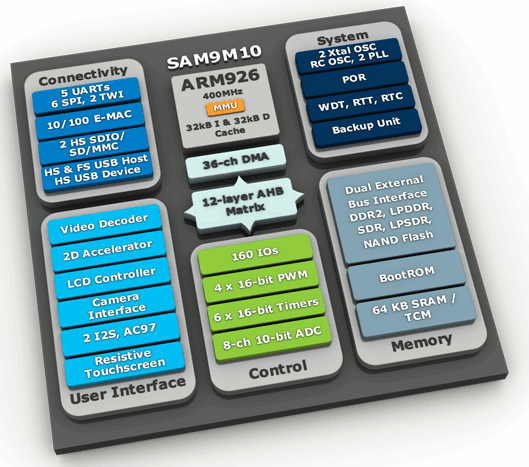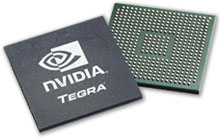Ayuda Media Systems announced OpenSplash – a free, open source digital signage player at ISE 2011. Press Release Excerpt: Ayuda Media Systems (“Ayuda”) announced today at ISE 2011 that it will be open sourcing its Splash Digital Player. Dubbed “OpenSplash”, it is a free, multi-platform open source player that can be driven by any content management and scheduling system. “Offering a free, open source media player will enable a new wave of innovation in the signage industry” said Andreas Soupliotis, President & CEO of Ayuda. “There are a multitude of software vendors in the space that basically all do the same thing – push content from a content management system (CMS) to a network of players. Some do it a little better than others but the differentiation of identity is just not there. If there were a standard open software player that the industry rallied behind then everyone could focus […]
Resources for Atmel AT91SAM9: SAM926X, SAM9GXX, SAM9M1X, SAM9XE…
Atmel AT91SAM9 – or simply Atmel SAM9 – series are versatile microcontrollers and embedded microprocessors used in variety of products such as internet radios, embedded p2p downloaders, smart grid in-home displays, and much more. Atmel SAM9 series are divided into five subsets: The original SAM9 MCU based on ARM926EJ-S running at between 210 and 240 Mhz, namely AT91SAM9260, AT91SAM9261, AT91SAM9261S and AT91SAM9263 SAM9G eMPU (Embedded MPU) based on ARM926EJ-S, a new generation based on SAM9 MCU architecture but running at between 266 and 400Mhz: AT91SAM9G10, AT91SAM9G20, AT91SAM9G45 and AT91SAM9G46. SAM9M eMPU based on ARM926EJ-S clocked at 400Mhz and with a video decoder: AT91SAM9M10 and AT91SAM9M11 SAM9R MCU based on ARM926EJ-S running at 210 Mhz with similar characteristic as the original SAM9 MCU, except it does not support USB Host but can be used as a High Speed USB device: AT91SAM9R64 and AT91SAM9RL64 SAM9XE MCU are also based on ARM926EJ-S running […]
Nufront ARM Cortex-A9 Laptop running Ubuntu at CES 2011
Nufront (新岸线) showcased their minipc based on Nusmart 2816 at Techcon 2010, they are now back at CES 2011 to show off their laptop reference designs. They provide two laptop designs with 10″ and a 14″ displays. The mother board is the same for both devices, only the casing changes to accommodate the display. The laptops runs Ubuntu and Android 2.2. They will also support some undisclosed operating system(s) later on (It should be Windows 8 and/or Chrome OS). The processor is a dual core Cortex A9 running at 2GHz, so I suppose this is the Nusmart 2816. The laptop will have 1 or 2 GB RAM depending on the configuration. Nufront said those laptops should be available within 6 months. No indication of price has been given. Jean-Luc Aufranc (CNXSoft)Jean-Luc started CNX Software in 2010 as a part-time endeavor, before quitting his job as a software engineering manager, and […]
Third Generation OLPC XO Laptop powered by ARM Marvell Armada 610
OLPC (One Laptop Per Child) was also at CES 2011 in Marvell stand with their third generation OLPC XO laptop named OLPC XO-1.75, after the first generation using AMD and the second Via Technologies. Charbax interviewed Ed NcNierney, Chief Technology Office at OLPC. They only changed the PCB in this version, i.e. the casing, keyboard, monitor is the same as the previous generations.The processor used in OLPC XO-1.75 is the ARM based Marvell Armada 610 (single core) running at 1GHz with 1GB RAM and 4GB Flash. The laptop can be recharged with a hand crane for 1 minute, then the laptop can be used for 10 minutes (color) and about 12 minutes (black and white). With the third generation, the price is only marginally cheaper than the previous generation (<200 USD), but the power consumption is now 2 Watt (instead of 4 Watt) and it is the most important part, […]
3D Capable Android Tablet: iStation Zood (Z3D)
iStation, a south korean company, announced the iStation Zood (codenamed Z3D) one the first (if not the first) stereoscopic 3D capable Android Tablet. You’ll need 3D content and wear polarised 3D glasses to take advantage of it. It features a 7″ multi-touch capacitive touchscreen and is powered by a Telechips ARM11 core processor (TCC8900?) running Android 2.1. The performance does not seem that great, but it’s still usable and being based on Telechips the price should be relatively low. Here are the Zood specifications on iStation website: Real 3D panel 7″ TFT-LCD (WVGA, 800×480) Capacitive touchscreen 16/32 Nand flash Acceleration sensor Wifi 802.11 b/g/n Bluetooth v2.1 + EDR FM Radio USB 2.0 Host and Slave SDHC card reader HDMI output Android 2.1 In the video below (but not in the specs?), they say this tablet also supports digital terrestrial television (DTT), now only supporting T-DMB, the standard used in south […]
Rockchip RK29xx Processors at CES 2011
Rockchip (瑞芯微电子), a Fuzhou (China) based company, showcased its new RK29XX processors at CES 2011. The processors are aimed at smartphones, mid, tablet and internet tv (smart tv) and compete directly with the like of Qualcomm snapdragon or Samsung Hummingbird. Here are the specs for the RK29XX series: 1.2 GHz ARM Cortex A8 core with Neon and 512KB L2 cache High performance 2D and 3D processors supporting OpenGL ES 2.0 and Open VG. The GPU can deliver up to 60 MT/s. 1080p video decoding for H.264, VP8, RV, WMV, AVS, H.263, MPE-4…. 1080p H.264 video encoding Supports DDRIII, DDRII, Mobile DDR memory 24-bit HW ECC for MLC Nand, support e-MMC boot 3 USB ports for device, host, 3G module 2 SD ports for SD card and WiFi Sensor interface for front and rear camera, up to 5M Standard TFT/EPD controller for variable panels 8 channel I2S and SPDIF TS port […]
The Next Version Microsoft Windows Will Support Embedded Systems based on Intel and ARM
Microsoft announced its new Windows operating system will support SoC based on ARM and is mainly working with NVidia (Tegra Processors), Qualcomm and Texas Instruments. This should allow their customers to provide a wider range of tablets running Windows OS. They will also keep working with AMD and Intel on their low power x86 processors. Here’s an excerpt of the press release: LAS VEGAS — Jan. 5, 2011 — Microsoft Corp. today announced at 2011 International CES that the next version of Windows will support System on a Chip (SoC) architectures, including ARM-based systems from partners NVIDIA Corp., Qualcomm Inc. and Texas Instruments Inc. On the x86 architecture, Intel Corporation and AMD continue their work on low-power SoC designs that fully support Windows, including support for native x86 applications. SoC architectures will fuel significant innovation across the hardware spectrum when coupled with the depth and breadth of the Windows platform. […]
Resources for NVidia Tegra 2
NVidia Tegra 2 is currently one of the most powerful processor used in smartphones and tablets such as the upcoming LG Optimus 2X smartphone or the new version of Samsung Galaxy Tab. NVidia describes the processor as follows: NVIDIA® Tegra™ 2 is the world’s most advanced mobile processor, featuring the world’s first mobile dual-core CPU for up to 2x faster Web browsing; the world’s only ultra-low power (ULP) NVIDIA® GeForce® GPU for up to 5x faster gaming; and the world’s first mobile 1080p HD video processor for flawless HD video conferencing and playback. Get never-before-seen experiences on a mobile device with NVIDIA Tegra. NVidia Tegra 2 is based on a dual core Cortex A9 running up to 1GHz, supports 32-bit DDR2 RAM and features NVidia Geforce GPU with OpenGL ES 2.0 support. Contrary to many other companies finding the development kit, documentations and tools is straightforward. Once you get to […]






